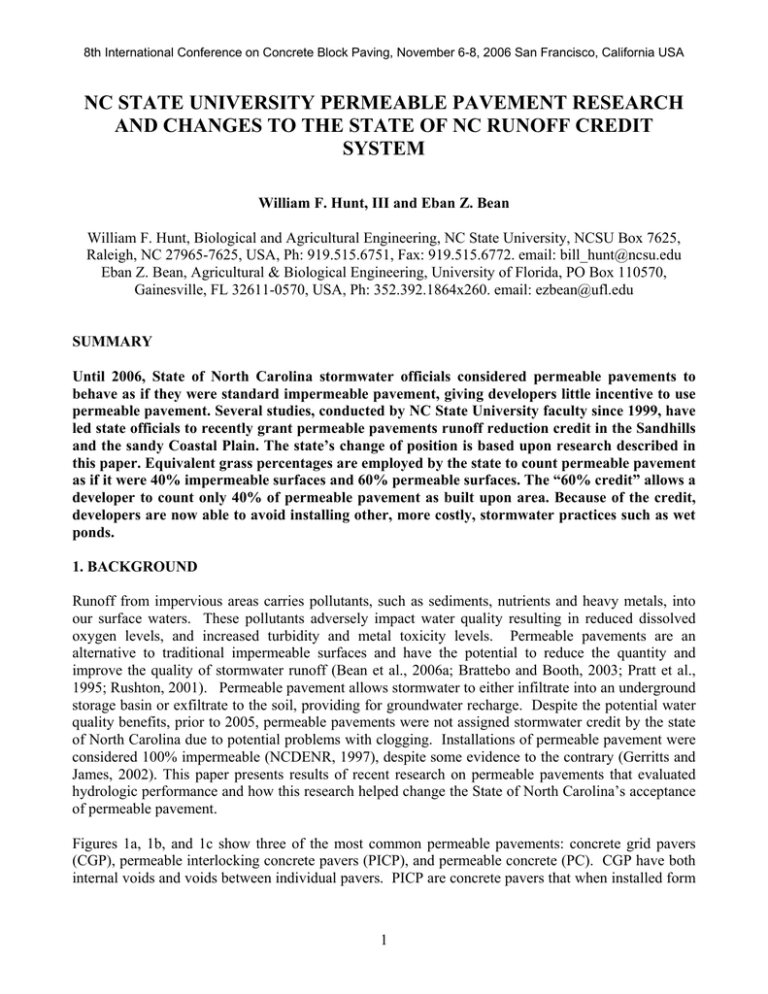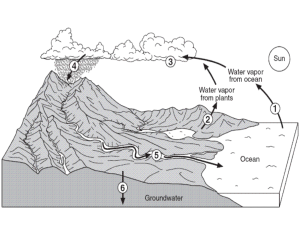NC State University Permeable Pavement Research, and Changes
advertisement

8th International Conference on Concrete Block Paving, November 6-8, 2006 San Francisco, California USA NC STATE UNIVERSITY PERMEABLE PAVEMENT RESEARCH AND CHANGES TO THE STATE OF NC RUNOFF CREDIT SYSTEM William F. Hunt, III and Eban Z. Bean William F. Hunt, Biological and Agricultural Engineering, NC State University, NCSU Box 7625, Raleigh, NC 27965-7625, USA, Ph: 919.515.6751, Fax: 919.515.6772. email: bill_hunt@ncsu.edu Eban Z. Bean, Agricultural & Biological Engineering, University of Florida, PO Box 110570, Gainesville, FL 32611-0570, USA, Ph: 352.392.1864x260. email: ezbean@ufl.edu SUMMARY Until 2006, State of North Carolina stormwater officials considered permeable pavements to behave as if they were standard impermeable pavement, giving developers little incentive to use permeable pavement. Several studies, conducted by NC State University faculty since 1999, have led state officials to recently grant permeable pavements runoff reduction credit in the Sandhills and the sandy Coastal Plain. The state’s change of position is based upon research described in this paper. Equivalent grass percentages are employed by the state to count permeable pavement as if it were 40% impermeable surfaces and 60% permeable surfaces. The “60% credit” allows a developer to count only 40% of permeable pavement as built upon area. Because of the credit, developers are now able to avoid installing other, more costly, stormwater practices such as wet ponds. 1. BACKGROUND Runoff from impervious areas carries pollutants, such as sediments, nutrients and heavy metals, into our surface waters. These pollutants adversely impact water quality resulting in reduced dissolved oxygen levels, and increased turbidity and metal toxicity levels. Permeable pavements are an alternative to traditional impermeable surfaces and have the potential to reduce the quantity and improve the quality of stormwater runoff (Bean et al., 2006a; Brattebo and Booth, 2003; Pratt et al., 1995; Rushton, 2001). Permeable pavement allows stormwater to either infiltrate into an underground storage basin or exfiltrate to the soil, providing for groundwater recharge. Despite the potential water quality benefits, prior to 2005, permeable pavements were not assigned stormwater credit by the state of North Carolina due to potential problems with clogging. Installations of permeable pavement were considered 100% impermeable (NCDENR, 1997), despite some evidence to the contrary (Gerritts and James, 2002). This paper presents results of recent research on permeable pavements that evaluated hydrologic performance and how this research helped change the State of North Carolina’s acceptance of permeable pavement. Figures 1a, 1b, and 1c show three of the most common permeable pavements: concrete grid pavers (CGP), permeable interlocking concrete pavers (PICP), and permeable concrete (PC). CGP have both internal voids and voids between individual pavers. PICP are concrete pavers that when installed form 1 8th International Conference on Concrete Block Paving, November 6-8, 2006 San Francisco, California USA voids located at the corners and midpoints of pavers. PC is different from standard concrete in that fine aggregate has been removed from the mix, allowing interconnected void spaces to form during curing. Permeable pavements allow drainage through the existence or formation of these void spaces. Figure 1a. PICP Figure 1b. CGP Figure 1c. PC Recent research conducted at North Carolina State University has focused on several topics relating to permeable pavement function, including: (1) water quality impacts of permeable pavement; (2) longer term runoff reduction; and (3) preventing and mitigating clogging of permeable pavements. The first and second studies examined three permeable pavement sites in North Carolina where water samples were collected for pollutant analysis. Two of these sites in eastern North Carolina were instrumented to measure rainfall and runoff rates. The third study monitored surface infiltration rates at 40 permeable pavement sites in North Carolina, Virginia, Delaware, and Maryland. Only topics (2) and (3) are discussed herein. 2. HYDROLOGIC MONITORING STUDIES 2.1 Longer Term Runoff Reduction Three permeable pavement sites across eastern North Carolina (located in Kinston, Wilmington, and Swansboro) were instrumented to determine runoff reduction performance. For each site, rainfall was measured onsite and runoff was routed over a weir for flow-rate measurement. The Kinston site was constructed of CGP filled with sand. The pavers were laid on 5 cm of bedding sand over a permeable geo-textile to prevent clogging of the storage basin (20 cm of washed No. 57 stone) below. The Wilmington site was constructed with 10 cm of permeable concrete (enough to store 2.5 cm of runoff) laid over top of a sandy base soil, with no gravel storage layer. The Swansboro water quality monitoring site, detailed previously, was also utilized for runoff reduction monitoring. 2 8th International Conference on Concrete Block Paving, November 6-8, 2006 San Francisco, California USA Æ Figure 2. Ratio of grassed area to impervious pavement area hydrologically equivalent to permeable pavement. For each hydrologic monitoring site, SCS Curve Numbers (CN’s) were determined for each event that was greater than 5.0 cm. CN’s are a measure of a surface’s permeability. Higher numbers mean more runoff (USDA, 1986) Equivalent CN’s were determined by back calculating through the SCS Curve Number equation. In addition, an equivalent ratio of grassed area (CN: 61) to pavement area (CN: 98) based on runoff depth for each event (> 5.0 cm) was calculated (Figure 2). 2.2 Hydrologic Monitoring Summaries The CGP site in Kinston was monitored from June 1999 through July 2001. During this period, six storms were greater than 5.0 cm, including Hurricane Floyd, which produced 36.8 cm of rainfall. For these storms, the median CN was 79 and the median equivalent percent grassed area was 62 (Table 1). Table 1. Calculated CN's for events greater than 2 in. from the Kinston CGP site. Rainfall (cm) Runoff Depth (cm) Site CN Grassed % 36.8 36.1 97 2 12.2 3.8 64 92 10.9 10.4 98 0 7.1 0.0 42 100 6.9 1.3 69 89 6.6 4.1 90 36 79 62 Median Rainfall and runoff were recorded at the Wilmington PC site from May 2002 through July 2003. Three storms produced at least 5.0 cm of rainfall; the largest was 9.7 cm. The median equivalent CN was 89 for these events, while the median equivalent grassed percentage was 42 (Table 2). Table 2. Calculated CN's for events 5 cm or greater from the Wilmington PC site. Rainfall (cm) 9.7 5.8 5.3 Median Runoff (cm) 7.1 3.3 0.3 Calculated CN 91 89 61 89 3 Grassed % 26 42 100 42 8th International Conference on Concrete Block Paving, November 6-8, 2006 San Francisco, California USA Table 3. Calculated CN's for events greater than 5 cm from the Swansboro PICP site. Rainfall (cm) 8.9 7.6 6.4 5.6 5.1 Median Runoff (cm) 0 0 0 0 0 Site CN 37 40 45 48 50 45 Grassed % 100 100 100 100 100 100 The Swansboro PICP site produced no runoff during monitoring from March to December 2004. Five storms were greater than 5.0 cm; the largest was 8.9 cm. For the same rainfall depths, based on the SCS Curve Number (CN) method, a grassed sandy soil (CN: 61) would produce runoff. For the storms monitored, the pavement reduced more runoff than a standard grass lawn. Therefore, the equivalent grass percentage was 100% for each event. The median SCS CN was 45 (Table 3). 2.3 Surface Infiltration Rate Results Surface infiltration tests were performed at 40 sites located in the mid-Atlantic and southeastern U.S. to determine whether maintenance significantly improved surface infiltration rates of CGP and whether surface infiltration rates of PICP and PC sites located near disturbed landscapes were significantly less than sites in stable watersheds (Bean et al., 2006b). Double-ring infiltrometers were primarily used to measure surface infiltration rates. However, single-ring infiltrometers were used instead for locations with rates too high (> 150 cm/h) for water to fill a double-ring infiltrometer. The double ring test requires the outer ring to maintain a constant hydraulic head. At high infiltration rates, water could not be poured into the outer ring quickly enough. The single ring infiltrometer was neither as precise nor as accurate as the double ring test. Three locations were tested at each pavement application. Each site’s surface infiltration rate was the average of three test locations, which in turn, was the average of three individual tests at each location. 2.3.1 Concrete Grid Pavers Of the 40 permeable pavement sites tested, surface infiltration tests were conducted at 15 CGP sites in North Carolina to evaluate the effect of maintenance on infiltration rates. Prior to the tests, the CGP voids were filled with sand and appeared to be mixed with additional coagulated material, indicating the potential for clogging or a reduced permeable condition. For each site, tests were run in three locations where the CGP surface remained unaltered. In three additional locations at the same permeable pavement application, accumulated materials in void spaces were removed to a depth between 12.7 and 17.8 mm to simulate maintenance by a vacuum truck. Surface infiltration tests were then run on the maintained locations and compared to the tests conducted on pavers with the nonaltered voids. Surface infiltration rates from sites with simulated maintenance were significantly (p = 0.007) higher than rates from existing surface conditions. Of the 15 sites tested, 14 had higher surface infiltration rates for the maintained locations. The median existing surface infiltration rate was 4.8 cm/h (ranging from 0.99 to 18.8 cm/h); the median maintained surface infiltration rate was 8.6 cm/h (ranging from 1.62 to 33 cm/h); an increase of 60%. 4 8th International Conference on Concrete Block Paving, November 6-8, 2006 San Francisco, California USA 2.3.2 Permeable Interlocking Concrete Pavers Surface infiltration tests were conducted at 14 PICP sites in Maryland (7), North Carolina (4), Virginia (2), and Delaware (1) to compare infiltration rates in stable versus disturbed, sediment transporting landscapes. At the time of construction, the gaps between each of the permeable interlocking concrete pavers were filled with pea gravel. However, it was observed that the five lowest infiltration rates at PICP sites were those with partially clogged surfaces due to sediment accumulation in the gaps initially filled with pea gravel. These five sites were all located adjacent to disturbed soils. The median surface infiltration rate for sites affected by sediments was 8.1 cm/h (ranging from 1.63 to 230 cm/h), while the median rate for sites without sediment accumulation was 2300 cm/h (ranging from 100 to 4000 cm/h); an increase in infiltration of over 99%. Sites without fines had significantly (p = 0.002) greater surface infiltration rates. Of note, the surface infiltration rates of sites with sediment accumulation were comparable to rates of CGP filled with sand. This is not surprising, due to the fact that sand was the primary soil type filling the gaps of the PICP. 2.3.3 Permeable Concrete Surface infiltration tests were conducted at 11 PC sites located in the Piedmont and Coastal Plain of North Carolina to compare infiltration rates in stable versus disturbed landscapes. The seven highest rates were from sites relatively free of fines, while the remaining four sites had sediment deposition on the surface. The median surface infiltration rate for sites free of fines was 3800 cm/h (ranging from 640 to 6600 cm/h); while the median surface infiltration rate for sites with evidence of fines was 13.5 cm/h (ranging from 11.4 to 28 cm/h). Surface infiltration rates of the four sites with fines were significantly lower (p = 0.008) than the seven sites free of fines. 2. 4 Surface Infiltration Rate Summary and Recommendations The study showed that removal of the top 12.7 to 17.8 mm of material accumulated from within CGP void spaces significantly improved surface infiltration rates. To maintain higher surface infiltration rates for concrete grid pavers filled with sand, maintenance, such as using a vacuum sweeper, should be performed on regular (quarterly to annual) intervals. Sand should then be backfilled into the void spaces to prevent clogging at greater depths. PICP and PC sites installed for runoff reduction should not be sited in areas prone to substantial sediment accumulation. Sources of sediments include vehicular traffic, wind blown sediments, and runoff from adjacent areas. Permeable pavements should be maintained regularly by use of a vacuum sweeper to mitigate sediment accumulation on the surface. Sediment removal should be addressed before fines are compacted into void spaces and possibly migrate to lower, harder to maintain depths within the pavement drainage profile. External sources of sediment should be closely monitored during construction of the permeable pavement to attain high surface infiltration rates. Of note, 37 of 40 sites had surface infiltration rates greater than 2.5 cm/h, which is comparable to rates expected for some hydrologic group A and B soils (loamy sands, sandy loams) covered with grass. Clogging at the permeable pavement surface in predominantly coarse grain (sandy) soil environments, therefore, does not cause a reduction in surface infiltration rates below some naturally grassed areas. 2. 5 Equivalent Grassed Percentage Table 4 summarizes surface infiltration data from sites in the Sandhills, Coastal Plain, and Coastal regions of North Carolina. Ranked percentages refer to the percent of sites with higher surface 5 8th International Conference on Concrete Block Paving, November 6-8, 2006 San Francisco, California USA infiltration rates. Thus, for the River Bend PICP site, 49% of the permeable pavement sites tested, located in the selected regions had surface infiltration rates at least 23.1 cm/h. Table 4. Surface infiltration rates and ranked percentage for sites in the Sandhills, Coastal Plain and Coastal regions of North Carolina. Surface Infiltration Ranked Rate (cm/h) Percentage1 Site Goldsboro PICP 4100 3 Dough Rollers PICP 2500 11 Harve de' Grace PICP 100 24 River Bend PICP 23.1 49 Atlantic Beach PC 14.0 51 Carrabba's CGP 7.4 76 FTCC I PA 5.3 89 Somerset Dr. PICP 1.5 100 1 - Sites fell approximately at 10, 25, 50, 75, and 90% of surface infiltration rates for sites in the Sandhills, Coastal Plain, and Coastal regions. By comparison, a study by Dr. Robert Pitt et al. (1999) found that the average infiltration rate of grassed urban sandy lawns in Birmingham, Alabama, was 6.35 cm/h. This value was used as a benchmark for converting surface infiltration rates of permeable pavements tested to equivalent grassed percentages. For surface infiltration rates of at least 6.35 cm/h, the equivalent grassed percentage would be 100% grass. From Table 4, 76% of the permeable pavement sites tested had surface infiltration rates (7.4 cm/h) at least as good as grass (6.35 cm/h). Therefore, 76% of sites tested had an equivalent grassed percentage of 100% grass, meaning they behaved as if they were 100% grass. Equivalent grassed percentages were calculated for representative permeable pavement sites in Table 6. The median equivalent grassed percentage value (used in Table 5) for surface infiltration rates was based on the 89th percentile, rather than the 50th percentile, to be conservative. From Table 4, 89% of sites tested were at least as permeable as 5.3 cm/h. Since 5.3 cm/h is 84% of the benchmark infiltration rate for grass of 6.35 cm/h, the equivalent grassed percentage for such sites would be 84% grass and 16% impermeable surface. In other words, a permeable pavement with surface infiltration rate of 5.3 cm/h behaves as if it were 84% grass and 16% impermeable surface. Approximately 90% of the permeable pavement sites tested behaved this way or were more permeable. Results of the equivalent percentages were presented to NC DWQ for consideration in giving stormwater credit for permeable pavement applications. 3. STORMWATER CREDIT Table 5 summarizes results from the three hydrologic monitoring sites and surface infiltration test comparisons. For each monitoring site, the permeable pavement sites produced substantially less runoff volumes than what would be expected from impermeable pavements. The hydrologic performance of these permeable pavement sites corresponded with lower CNs than traditional 6 8th International Conference on Concrete Block Paving, November 6-8, 2006 San Francisco, California USA impervious surfaces (98). Therefore, correctly using permeable pavements may reduce runoff volumes and thus reduce pollutant loadings. Table 5. Summary table of median equivalent grassed percentages and curve numbers. Site Wilmington PC Kinston CGP Surface Infiltration Rate Comparison Swansboro PICP Calculated CN 89 79 N/A 45 Median Equivalent Grassed Percentage 42 62 84 100 Based on the surface infiltration and hydrologic monitoring studies performed in this project, as well as results from additional research, the authors suggested a credit system for permeable pavements in North Carolina. Permeable pavement sites (e.g., pervious concrete) that are constructed without a gravel storage basin, located in areas with in-situ sandy soils, and maintained regularly should be considered 60% impervious and 40% grassed area. Conversely, permeable pavement sites that meet the above requirements, but also have an unlined gravel storage basin of at least 15 cm washed stone (such as the Kinston CPG site) should be considered 40% impervious and 60% grassed area. As permeable pavement hydrologic performance is researched further and monitored, these ratios may be adjusted. 4. CONCLUSIONS Until 2006, State of North Carolina stormwater officials considered permeable pavements to behave as if they were standard impermeable pavement, giving developers little incentive to use permeable pavement. Several studies, conducted by NC State University faculty since 1999, have led state officials to recently grant permeable pavements runoff reduction credit in the Sandhills and the sandy Coastal Plain. The state’s change of position is based upon research described in this paper. Equivalent grass percentages are employed by the state to count permeable pavement as if it were 40% impermeable surfaces and 60% permeable surfaces. The “60% credit” allows a developer to count only 40% of permeable pavement as built upon area (NC DENR, 2006). Because of the credit, developers are now able to avoid installing other, more costly, stormwater practices such as wet ponds. More work is continuing to evaluate how different types of permeable pavements reduce runoff and improve water quality at a side-by-side testing location in Kinston, NC. Perhaps these data, together with water quality data (Bean et al., 2006a), will allow state government officials to determine whether different permeable pavements should be given various pollutant removal credit. The studies also showed that to achieve optimal hydrologic performance, permeable pavements should be sited away from locations prone to sediment accumulation, be constructed with a storage basin of washed stone, and be maintained by a vacuum sweeper on a frequent basis. Since sites with lined storage basins do not effectively increase infiltration to soil, credit was only suggested for permeable pavement sites in sandy soil environments. 7 8th International Conference on Concrete Block Paving, November 6-8, 2006 San Francisco, California USA ACKNOWLEDGEMENTS The authors would like to thank NC Department of Environment and Natural Resources’ Division of Water Quality and the Interlocking Concrete Pavement Institute for providing funds for this research. Additionally, staff from the City of Kinston, Mickey’s Pastry Shop, Town of Swansboro, and City of Wilmington provided tremendous support. Several staff and faculty at NCSU assisted including Jonathan Smith, David Bidelspach, Brandon Eckrote, and Zach Woodward. REFERENCES Bean, E.Z., W.F. Hunt, and D.A. Bidelspach, 2006a. Evaluation of four permeable pavement sites in eastern North Carolina for runoff reduction and water quality impacts. Journal of Irrigation and Drainage Engineering, (accepted). Bean, E.Z., W.F. Hunt, and D.A. Bidelspach. 2006b. A field survey of permeable pavement surface infiltration rates. Journal of Irrigation and Drainage Engineering, (accepted). Brattebo, B.O. and D.B. Booth. 2003. Long-Term stormwater quantity and quality performance of permeable pavement systems. Water Research, 37(18), pp. 4369-4376. Gerritts, C. and W. James. 2002. Restoration of infiltration capacity of permeable pavers. In: Proc. 9th International Conference on Urban Drainage. ASCE. Portland, Ore. North Carolina Department of Environment and Natural Resources (NCDENR). 1997. Stormwater Best Management Practice Design Manual. Raleigh, N.C. North Carolina Department of Environment and Natural Resources (NCDENR). 2006. Stormwater Best Management Practice Design Manual: Permeable Pavement Revision. Raleigh, N.C. 11 p. Pitt, R.E., J. Lantrip, R. Harrison, C.L. Henry, and D. Xue, 1999. Infiltration through Disturbed Urban Soils and Compost-Amended Soil Effects on Runoff Quality and Quantity. US EPA. Cincinnati, OH. Pratt, C. J., J.D.G. Mantle, and P.A. Schofield, 1995. UK research into the performance of permeable pavement, reservoir structures in controlling stormwater discharge quantity and quality. Water Science and Technology, 32(1), pp. 63-69. Rushton, B., 2001. Low-impact parking lot design reduces runoff and pollutant loads. J. Water Resources Planning and Management, 127(3), pp. 172-179. U.S. Department of Agriculture (USDA). 1986. Soil Conservation Service. “Urban Hydrology for Small Watersheds,” Technical Release No. 55, Washington, DC. 8




